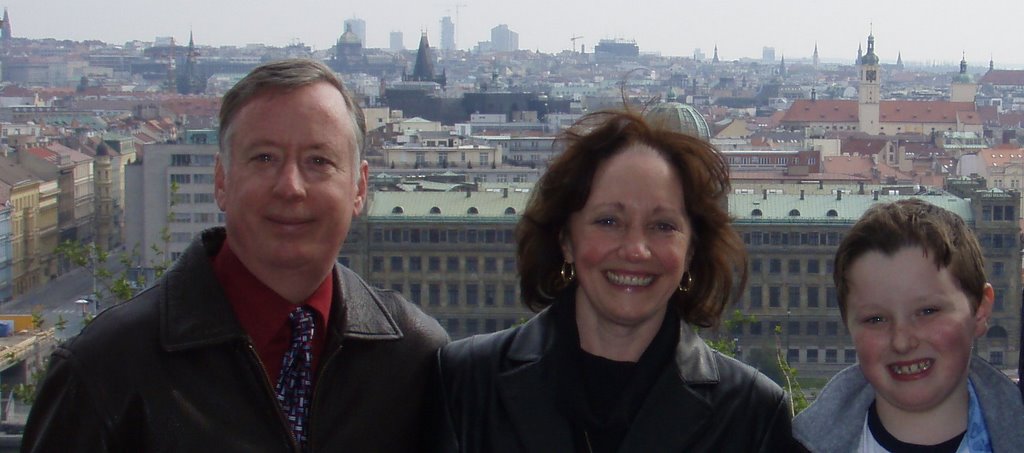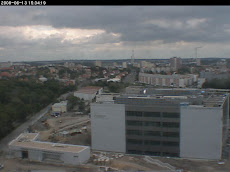Here is an article about the Nusle bridge in Prague that connects New Town to Vysehrad. The red line metro passes through it, and there is a nice park under part of it. We have been over it several times and visited the park a couple of times. It's very big and the fact that it's made of nothing but concrete makes it very imposing. It is not a subtle bridge.
Praguescape: Birthday bridge
By Kristina Alda / Prague Daily Monitor / Published 26 February 2008
When I told my father I had spent a Sunday afternoon strolling on Prague's Nusle Bridge, for a split second, he seemed a little worried. After all, Nuselák, as locals call it, belongs among the city's most popular destinations for suicide jumpers, and that's what the bridge has become best known for.
Its architectural merits are often overlooked. That's surprising, since many consider it an engineering marvel. In fact, the bridge, which celebrated its 35-year anniversary last Friday, was named the Structure of the Century in the transportation building category in 2000. 
As bridges go, Nuselák isn't pretty. It doesn't share the ethereal beauty of the Golden Gate Bridge or of the George Washington Bridge. It certainly lacks the handsome hoariness of the Charles Bridge or of the Pont d'Avignon. Nuselák is imposing the way a bare rock face is imposing – for its sheer height, mass and sturdiness.
Spanning from New Town to Vyšehrad, high above the sleepy streets of Nusle, the Botič brook and railway tracks, the bridge is 486 metres long, and its four pillars are roughly 42 metres tall. It's part of the four-lane magistrála freeway, and the C-line metro passes through its interior, travelling from I.P. Pavlova to Vyšehrad.
Construction began in 1965, based on a design by architects Svatopluk Kobr, Vojtěch Michálek and Stanislav Hubička, and took five years to complete. Sixty-six tanks rolled over the bridge in 1970 to test the sturdiness of the concrete and steel skeleton structure. Later, explosives were fired off the bridge to further test its strength.
Like so many of Prague's Cold War structures, the bridge bears the marks of the country's communist history. Its opening in 1973 coincided with the 25-year anniversary of the Czechoslovak coup d'état of 1948, known as Vítězný únor. The bridge originally bore the name of Czechoslovakia's first communist president, Klement Gottwald. It was renamed to Nuselský most in 1990, following the Velvet Revolution. 
Plans for a bridge over Nusle date back to the early 20th century, but the two wars delayed construction for decades. The concrete behemoth that was eventually commissioned by communist authorities was far removed from earlier, more elegant iron designs. It would be nice to be able to say that the bridge, in its uncompromisingly stark ugliness, has become a period piece, a reminder of the country's grimmest years. If you take a look at the concrete railway overpass that's going up between Žižkov and Karlín, however, you will notice striking similarities to Nuselák.
Grimmer still than Nuselák's architectural legacy are its suicide statistics. The bridge has been attracting jumpers since the first days following its opening. About eight people jump off Nuselák each year, and by 2000, the bridge had claimed an estimated 300 lives. Authorities installed 2.7-metre-tall metal railings in 1997 in the hope of detracting people from jumping, and smooth metal barriers were added at either end of the railing last year to make climbing over even more difficult.
The measure seems to be helping; according to a recent Mladá fronta Dnes article, there hasn't been a single suicide on Nuselák in the last six months. This is good news not just for paramedics, but also for those living near the bridge, as there have been several rare incidents reported where jumpers landed on pedestrians passing below.
On my recent Nusle walk, though, as I wandered along the bottom of the valley to the base of the bridge, it was hard to believe this was the site of hundreds of tragedies. I was only reminded when I passed by the rather morbidly named U Skokana (The Jumper) bar on Oldřichova Street. From below, contrasting against a solid blue sky, the bridge looked more like some absurdly geometrical rock formation than a piece of architecture – as though it's been part of the local landscape for centuries.
The view from the top, meanwhile, was spectacular as I walked along the span from Vyšehrad to New Town. The Žižkov TV tower jutted up on the horizon to my right, to the left was Petřín hill and, directly below, the meandering Botič brook and the tidy, car-lined streets of Nusle, all submerged in a quiet Sunday lull.
Kristina Alda can be reached at kristina@praguemonitor.com
Tuesday, February 26, 2008
Prague's Nusle Bridge...
Subscribe to:
Post Comments (Atom)


1 comment:
"the bridge had claimed an estimated 300 lives"??? It must have stole them away during the night and tossed them off...
Post a Comment